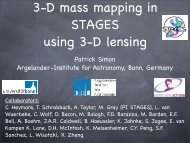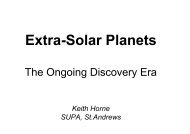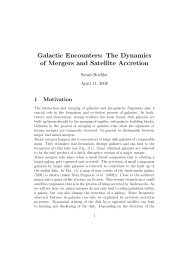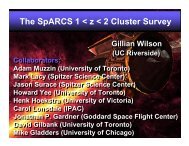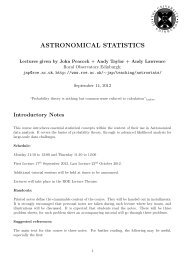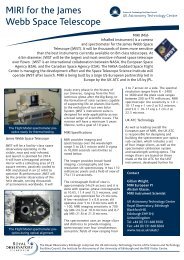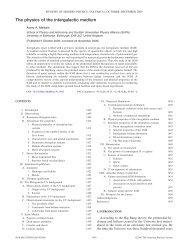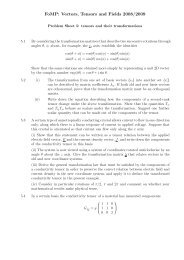Physical Characterisation of the Binary EKBO 2001 QT297
Physical Characterisation of the Binary EKBO 2001 QT297
Physical Characterisation of the Binary EKBO 2001 QT297
Create successful ePaper yourself
Turn your PDF publications into a flip-book with our unique Google optimized e-Paper software.
Draft<br />
In ei<strong>the</strong>r case, <strong>the</strong> implication remains that this was not a tidally evolved pair that underwent<br />
some gentle perturbation <strong>of</strong> <strong>the</strong> orbit to a more distant semi-major axis (i.e. via <strong>the</strong> effect <strong>of</strong> solar<br />
tides). Ra<strong>the</strong>r, <strong>the</strong> evidence for rapid variations is suggestive <strong>of</strong> <strong>the</strong> secondary component having<br />
undergone a subsequent impact that imparted both a change in orbital angular momentum to <strong>the</strong><br />
system as well as rotational angular momentum to <strong>the</strong> body. Unfortunately <strong>the</strong> timescale for tidal<br />
evolution <strong>of</strong> <strong>the</strong> two components in <strong>the</strong>ir current orbit is longer than <strong>the</strong> age <strong>of</strong> <strong>the</strong> solar system<br />
and <strong>the</strong>refore not constraining on <strong>the</strong> time that such an impact occurred.<br />
Colors:<br />
Two color observations (using Sloan g’,r’, i’ filters) were obtained for both binary components at<br />
a single phase on UT 13 July 2002. Applying zero-point magnitude and extinction corrections,<br />
calculated from a set <strong>of</strong> Sloan standard star observations, to <strong>the</strong> PSF fits for this night yields<br />
primary and secondary magnitude estimates listed in Table 2. While we make use <strong>of</strong> <strong>the</strong> Sloan<br />
filters for <strong>the</strong>ir well defined bands and high throughput, we have adopted <strong>the</strong> transformation<br />
equations <strong>of</strong> Fukugita et al.,1996 to estimate <strong>the</strong> more <strong>of</strong>ten used BVRI colors for each<br />
component <strong>of</strong> <strong>the</strong> binary system. The primary component is consistently about three tenths <strong>of</strong> a<br />
magnitude redder than solar colors and well within <strong>the</strong> ‘normal’ range <strong>of</strong> small outer solar system<br />
bodies. At this phase, <strong>the</strong> secondary component colors are identical to <strong>the</strong> primary within <strong>the</strong><br />
uncertainties.<br />
Table 2. <strong>2001</strong> QT_297 colors<br />
Object Julian Date g’ r’ i’ B-V a V-R a R-I a<br />
Primary 2452468.785 23.79 ± 0.03 22.94 ± 0.02 22.55 ± 0.01 1.01 ± 0.04 0.61 ± 0.04 0.64 ± 0.03<br />
Secondary 2452468.785 24.41 ± 0.07 23.55 ± 0.05 23.26 ± 0.05 1.00 ± 0.08 0.61 ± 0.07 0.59 ± 0.06<br />
Secondary del_mag(r’)- del_mag(i’) b r’-i’ R-I<br />
2452468.785 -0.01 ± 0.05 0.29 ± 0.05 0.53 ± 0.06<br />
2452473.740 -0.02 ± 0.13 0.28 ± 0.13 0.52 ± 0.13<br />
2452473.800 0.24 ± 0.10 0.54 ± 0.10 0.79 ± 0.10<br />
2452473.868 0.13 ± 0.19 0.43 ± 0.19 0.68 ± 0.19<br />
2452214.525 -0.09 ± 0.18 0.21 ± 0.18 0.45 ± 0.18<br />
2452215.520 -0.01 ± 0.12 0.29 ± 0.12 0.53 ± 0.12<br />
2452216.510 -0.41 ± 0.16 -0.11 ± 0.16 0.12 ± 0.16<br />
a using transformations <strong>of</strong> Fukugita et al., 1996 b differential magnitudes between primary and secondary<br />
While accurate two color observations have only been obtained on one night thus far in our runs,<br />
we have obtained single color (Sloan r’ and i’) observations on five nights including very modest<br />
temporal coverage on UT 18 July 2002. Recognizing <strong>the</strong> variability <strong>of</strong> <strong>the</strong> secondary outlined in<br />
<strong>the</strong> preceding section and using <strong>the</strong> differential magnitudes for both <strong>the</strong> Sloan r’ and i’ filters<br />
tabulated in Table 1, our admittedly sparse data set is suggestive <strong>of</strong> possible strong color<br />
variation across <strong>the</strong> surface <strong>of</strong> <strong>the</strong> secondary component. Moreover, R-I colors (derived from <strong>the</strong><br />
r’-i’ measurements) cover a magnitude range from 0.79+/-0.10 to 0.12+/-0.16 (Table 2 lower)<br />
indicating one <strong>of</strong> <strong>the</strong> reddest and <strong>the</strong> bluest EKO surface measured in <strong>the</strong>se passbands (cf. Jewitt<br />
and Luu, <strong>2001</strong>). Interestingly, <strong>the</strong> bluest measurements (recorded on UT 03 November <strong>2001</strong>)<br />
correspond to at or near <strong>the</strong> peak brightness <strong>of</strong> <strong>the</strong> <strong>2001</strong> QT_297 secondary while <strong>the</strong> reddest<br />
measurements (recorded UT 18 July 2002) correspond to at or just preceding <strong>the</strong> minimum<br />
brightness <strong>of</strong> <strong>the</strong> secondary. This again hints toward an impact origin for <strong>the</strong> present orbit <strong>of</strong><br />
this binary where <strong>the</strong> blue/bright region can be interpreted as fresher excavated material, <strong>the</strong>



